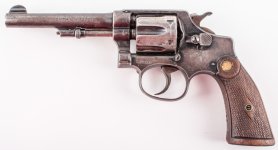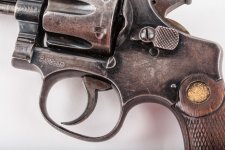Thanks for the replies! The stamped name is actually "O.WELLS", not only is it stamped on the sides of the frame, but on the bottom of the grips also. I am not selling it, but was wondering what the value might be (picked it up for 140 bucks). Bore and cylinders are fine, locks up firm, are there any concerns I should address prior to firing it?
OLD GUN PROTOCOL:
Simply put, the only usual issue with these marvels of yesteryear is they are gummed up and dirty. Old oils of its time do not match the quality of these old guns nor the science of today, and actually dry up and harden to the point of impeding operation and accelerating wear. The simple solution does not need a gunsmith. Just one of a few premium modern gun products from any sporting goods, gun store or hardware store.
Most are both cleaning and preserving agents; Breakfree, Kroil & M-Pro7 are some of the best, but there are others. Disassembly is not necessary. With grips removed and a spray can version of the product, flood and flush the revolver thru every opening and crevice until the black gunk stops flowing out, let it drain for an hour and wipe it down good.
To remove grips: loosen the grip screw completely and carefully push down on the screw head until the bottom grip separates, then remove. Now push the top side grip off with a finger or toothbrush from the backside thru the grip frame. Scrub barrel bore and cylinder chambers with a simple cleaning rod kit found at the same places as the cleaning agents above, and patches cut from rags is all you really need. And scrub any observed exterior and crevice crud with an old toothbrush with bristles cut off short for stiffness.
Once cleaned and lubricated, with a few simple checks you can determine if it’s safe to use. Open the cylinder and verify the barrel is unobstructed. Cock the hammer slowly and confirm the cylinder is locked in position for each of the 6 chambers. If satisfactory, now operate the gun by pulling the trigger slowly until the hammer drops. Again, confirm each time after cycling the action, that the cyl is still locked in position. Cock the hammer in single action mode. Gently push on the hammer to confirm that it will not drop w/o pulling the trigger.
You have a quality made, very well engineered, and assembled with skilled craftsmanship and hand fitted revolver, no longer affordable on a competitive market basis, and that we'll never see again, ever.
Shoot it to your hearts delight, and it will delight you with its fine accuracy, and comfortable recoil.






